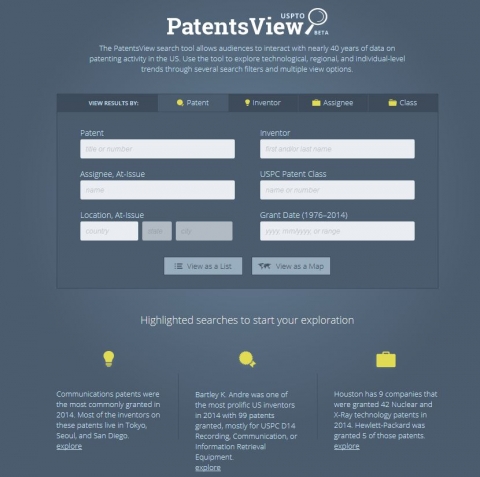Sep172015
Posted at 11:38 AM
Bureaus within the Department of Commerce (DOC) create collaborative opportunities with other federal agencies and the public to foster an open government. Our open data initiatives help us make strides in this direction. For the last 225 years, data from the United States Patent and Trademark Office (USPTO) has documented inventive ideas, and in turn has served as a source of continuing, follow-on innovation. This data has become a cornerstone of economic opportunity for businesses and entrepreneurs, and a foundation of greater prosperity. Making USPTO data available is at the heart of USPTO and DOC efforts to provide transparency and synergy with the public we serve.
In collaboration with the Center for the Science of Science and Innovation Policy, the USPTO is launching a prototype web tool called PatentsView this month. Individuals will be able to explore nearly 40 years of data on patenting activity in the United States. Users can search data as far back as 1976 by patent titles and types, inventors, assignees, patent classes, locations, and dates. Each search includes graphic illustrations such as charts and maps. These data visualizations quickly reveal concentrations of patent activity and trends. Using the results, a previously unseen spider web of interconnected information can emerge.
How many patents are owned by your favorite company? Who are the most prolific inventors? What technology areas are surging or declining? Is Boston or San Diego the leading region for biotechnology patents? Until now, answering these questions would require multiple resources and countless patent searches. One could easily spend hours or even days of tireless research to get this information–if at all. With PatentsView this information is available at your fingertips.
Researchers, inventors and startups can quickly identify the inventive leaders in their technologies and know where they are. This foundational information can serve as a resource for research driving strategic business decisions.
The PatentsView platform is built on a database that longitudinally links inventors, their organizations, locations, and overall patenting activity using derived data from the USPTO bulk data files available to the public. It provides a user-friendly visualization tool, query tool, and a flexible application programming interface (API) that will allow quick access to USPTO patent data for a broad range of users, including programmers and application developers. Individuals can use the flexible API to create applications to help students and others take advantage of the wealth of information.
The USPTO is hosting a public workshop Sept. 24 where experts in patent data, open data, science, and innovation will showcase novel approaches for differentiating inventors with the same name across decades of U.S. patent data. During this ‘Inventor Disambiguation Workshop,’ teams will present their new algorithms, which were submitted to a panel of judges prior to the event. The winning team’s algorithm will be integrated into PatentsView and made available to the public. While PatentsView already uses an algorithm to disambiguate inventors, opportunities for improvements are always emerging as technology evolves.
PatentsView is just one component of a much broader, agency-wide open data initiative at the USPTO. With an understanding that better data leads to better decision-making by those building and growing America’s economy, the USPTO seeks to improve the discoverability, accessibility, and usability of valuable patent and trademark information for the public.
The PatentsView initiative started in 2012 as a collaborative effort between the USPTO, the U.S. Department of Agriculture, the Center for the Science of Science and Innovation Policy, and the University of California at Berkeley. With the USPTO’s culture of open data and collaboration, PatentsView is an example of what is possible when data is made public and structured in a way that enables it to be fully discoverable and usable by end users. It can be freely used, reused and redistributed by anyone. Its value lies not only in what it does today, but also in what it can do in the future.

